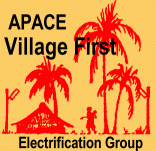|
Back to project list
Ghatere
A micro hydroelectric system for village operation, village ownership and village self-maintenance.
Ghatere is a village on Kolombangara Island, in the West of the Solomon Islands. It lies a few km from Vavanga, or about 30 minutes by paddle canoe, or walking a circuitous track. Ghatere is a large village of around 350 people, with a clinic and a school, to which children from Vavanga and Iriri villages paddle each morning. Access by land is not easy.
At the opening and hand-over of APACE's first completed project at Iriri in 1983, many Ghatere people came to join in the ceremony and to take pride in their own helping hand during the hard work of constructing Iriri's hydro power system. The people of Ghatere, Vavanga and Iriri are closely related, although not generally of the same tribe. There were purportedly 400 village chiefs at that Official Opening, such is the power of the word-of-mouth communication system in Solomon Islands, and all were very curious and surprised at the notion of village people controlling their own destiny through such a relatively large and sophisticated community project effort. None were more enthusiastic than Ghatere leaders, including Lisi Pio, Singi, Silas Bio, Eyland, and Sobatu, despite their first-hand knowledge of the work and responsibilites that are entailed in such a venture.
There were several site visits over the following eight years. APACE volunteers Paul Bryce, Ken Offord, Donnella Bryce and later Paul Parker tended to take opportunities (when in that area for other project duties) to discuss the implications of a Ghatere project, in terms of management needs, responsibilities on both sides and the challenges that would be faced. Donnella responded to Ghatere's persistent requests with information about community development, hydro system benefits and costs, and encouraged community meetings and self-appraisal processes that allowed APACE to gain a working knowledge of community management. Enthusiasm from Ghatere people refused to wane during this protracted period, despite APACE's lack of available funds or resources.
APACE eventually gathered a small residual of funds from its members, and some funds were raised by Ghatere pople through a community hydro fund. The Australian Government provided support through a limited subsidy scheme for NGO development assistance, and the Adventist Development Relief Agency offered their support as the project got underway. Paul Parker became the APACE project manager over many years of voluntary work, and the Ghatere Community provided local management through their elected hydro committee. Ian Scales developed designs for the hydro system, particularly its civil works,and also spent many months of voluntary effort on site.
The Ghatere project proceeded as a joint venture with ADRA's financial assistance, APACE's design and voluntary implementation efforts, and Ghatere community's teamwork with Paul and Ian and help from volunteers from nearby Vavanga and Iriri. The work has proceeded through some setbacks and delays. At an early stage, the work encountered evidence of stone terraces constructed before modern missionary times, and the civil works was redesigned to avoid disturbance of a sensitive and potentially valuable historical site.
The Ghatere hydro system diverts a portion of the large and slow flowing Ghatere River, sampling somewhere between 100 litres per second and 300 litres per second depending on the season and the village electricity demand.
A hand built earth-lined headrace channels this water some 300 metres around a contour of the nearby hillside. The headrace ends at a concrete settling tank, before the water proceeds down 2x250 mm diameter uPVC penstock pipes to enter a double crossflow turbine built specifically for Solomon Island conditions by the Australian owned manufacturer, Pelena Pty Ltd.
APACE designed a protection circuit in UTS laboratories that acts to ensure machinery is not damaged by unforseen conditions, such as penstock blockages or transmission line breakage through cyclone or other misadventure.
Project Details
Project Scope
Village development
Back to project list
|





